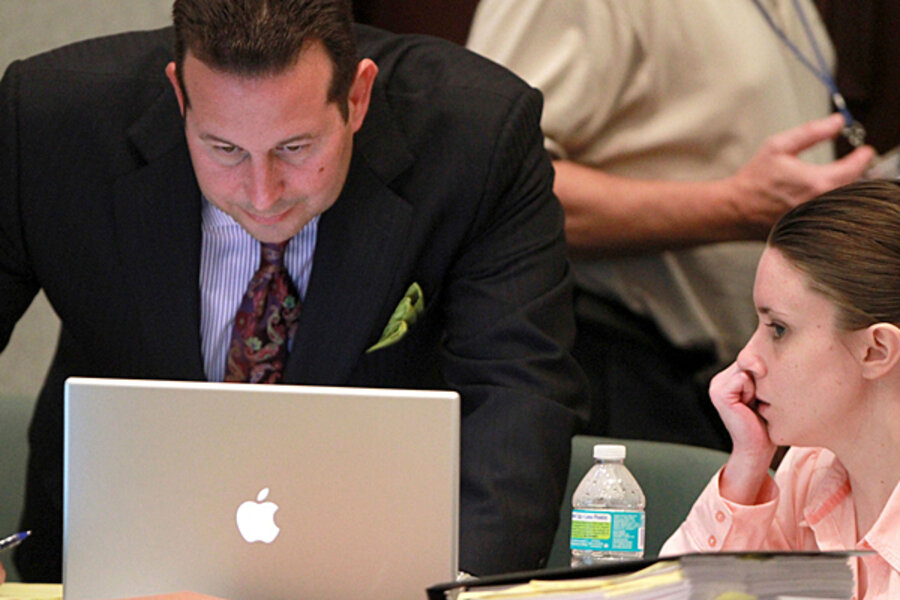Casey Anthony trial: Internet searches for 'chloroform' take center stage
Loading...
Chloroform took center stage on Wednesday at the first-degree murder trial of Casey Anthony, the Florida mother accused of killing her 2-year-old daughter.
Jurors at the Orlando trial heard testimony from a computer forensics expert that he discovered Google and Wikipedia searches for “chloroform” and “How to make chloroform” on a desktop computer in the Anthony home.
The computer searches were conducted at a time when both of Ms. Anthony’s parents were away at work.
The testimony is important because it supports the prosecution’s theory that Anthony used chloroform to subdue her daughter, Caylee, before suffocating her by wrapping the toddler’s head in duct tape. The dead child’s body was then kept for a period of time in the trunk of Ms. Anthony’s car, prosecutors allege.
The Internet search is also important to the prosecution’s case because the searches were conducted in March 2008, roughly three months before Caylee went missing. Prosecutors will cite the chloroform search as evidence that Caylee’s death was premeditated.
Anthony is charged with first degree murder. If convicted she could receive a death sentence.
Defense lawyers maintain that Caylee died accidentally in the family swimming pool and that Casey and her father, George, tried to cover up the death by making it appear a kidnapping and murder.
Caylee was missing for a month before her mother told her parents and the police. The report of her missing daughter triggered a nationwide search and hundreds of leads.
Investigators quickly shifted their efforts from a missing persons case to a homicide.
'Residue of chloroform'
Prosecutors are highlighting chloroform as a key piece of the puzzle.
On Tuesday, a forensic chemist with the Federal Bureau of Investigation testified that he found “residue of chloroform” on samples taken from the liner and spare tire cover in the trunk of Anthony’s 1998 Pontiac Sunbird.
But the expert, Michael Rickenbach, also acknowledged on cross examination that similar quantities of chloroform can be found in household cleaning products.
A bag of trash left for an extended period in the car trunk included a used bottle of laundry detergent.
Prosecutors had asked Dr. Rickenbach to testify about the quantity of chloroform in the trunk, but he declined to do so. He said the tests he performed were designed to detect the presence of elements of chloroform, not establish the quantity of chloroform present.
“I would not want to give an impression of the amounts within these samples, it is not appropriate given the tests I did,” Rickenbach testified.
“As a scientist you want to be precise,” defense attorney Jose Baez asked.
“Yes,” he said.
“Especially in a court of law,” Mr. Baez asked.
“Yes,” he added.
A day earlier, on Monday, a different prosecution witness, research scientist Arpad Vass, testified that his instruments showed “shockingly high” amounts of chloroform in the car trunk.
'Chloraform'
The key witness on Wednesday was computer forensics expert John Dennis Bradley, the developer of a software program used by law enforcement to identify Internet activities on a computer hard drive after they’ve been deleted. [Editor's note: The original version misidentified Mr. Bradley. His name has been corrected throughout the story.]
Mr. Bradley said he was asked to examine the hard drive of the desktop computer from the Anthony home for any reference to chloroform. The request was made by investigators after tests performed by Dr. Vass revealed the presence of chloroform in the car trunk.
In addition to the words “chloroform” and the misspelled “chloraform,” he also discovered search words including inhalation, alcohol, peroxide, head injuries, ruptured spleen, chest trauma, internal bleeding, neck breaking, death, hand-to-hand combat, and self defense. The relevant searches took place on March 17, 2008 and March 21, 2008.
Baez attempted to paint the Internet activity as casual and harmless internet surfing. He suggested that the chloroform search may have been triggered by a gag photo on a MySpace page maintained by one of Anthony’s former boyfriends.
The photo shows a woman at a fancy restaurant in a black dress with a man kissing her neck and holding up a white napkin. The caption reads: “Win her over with chloroform.”
Three minutes vs. 84 visits
On cross examination, Bradley was asked the longest time anyone spent on the home computer looking at websites dealing with chloroform.
Baez volunteered that in the two days together [March 17 and 21] the chloroform searches took up “a little over three minutes in total.”
“Yes, I would agree with that,” Bradley said.
Assistant State Attorney Linda Burdick responded by asking Bradley how often someone on the Anthony’s home computer had visited a particular website dealing with the making of chloroform.
Bradley said the site had been visited 84 times.
“Was this surfing the web for information about weapons and chloroform and how to make chloroform,” Ms. Burdick asked.
“Yes,” Bradley said.
“When someone types into a search engine how to make chloroform, maybe they are trying to find out how to make chloroform,” she asked.
Before Bradley could answer Baez objected to the prosecutor delivering a speech to the jury rather than a question to the witness. The judge sustained the objection.





